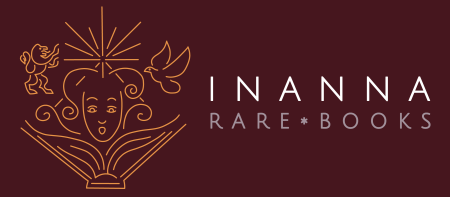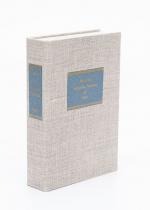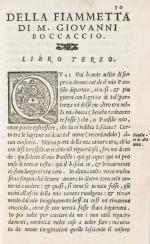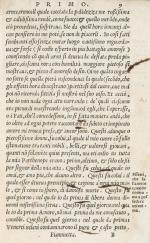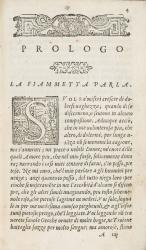Boccaccio, L'amorosa fiammetta di M. Giovanni Boccaccio, di Nuovo Corretta et Ri
L’amorosa fiammetta di M. Giovanni Boccaccio, di Nuovo Corretta et Ristampata, con La Tavola et le Postille delle cose Piu Notabili.
Venetia, Appresso I Gioliti, 1584. 9.5 cm x 15.4 cm. 107, [1] pages including illustrated titlepage with Giolito’s printer mark and Giolito’s stunning colophon of Phoenix rising from the ashes and the Motto: “Semper eadem” (″Always the same”). Hardcover in custom – made solanderbox. Recently rebound in half-leather with marbled paper-covered-boards. The bookblock in very good condition with some minor, contemporary inkstains. Name of preowner “Exlibris Bernard Rielliae [″Bernard Reilly”] in contemporary ink (16th or 17th century entry). Small lesion to titlepage and first three pages only. Very faint, faded dampstain to the outer margins of a few pages.
This is one of the rare Giolito editions of Boccaccio’s “L’Elegia di Madonna Fiammetta”, in which the important italian publisher, Gabriel Giolito, added a two-page-dedication to the women of Citta di Casale.
His dedication reads: to the “Gentili et Valorose donne della Città di Casale di Monferrato” (Gentle and Valorous women of the city of Casale Monferrato). This early dedication to women conveyed what later became the normative terms of Giolito’s advertising techniques. According to Giolito, L’amorosa Fiammetta was ideal feminine reading since it narrated a woman’s amorous
experiences” (Source: Androniki Dialeti – “The Publisher Gabriel Giolito de’ Ferrari, Female Readers, and the Debate about Women
in Sixteenth-Century Italy”)
Elegia di Madonna Fiammetta, or The Elegy of Lady Fiammetta in English, is a novel by the Italian writer Giovanni Boccaccio, probably written between 1343 and 1344. Written in the form of a first-person confessional monologue, it describes the protagonist, Fiammetta’s, passion for Panfilo, a Florentine merchant, and takes place in Naples. It has been characterised as the first psychological novel in Western literature. It consists of a prologue and nine chapters. (Wikipedia)
Giovanni Boccaccio (16 June 1313 – 21 December 1375) was an Italian writer, poet, correspondent of Petrarch, and an important Renaissance humanist. Boccaccio wrote a number of notable works, including The Decameron and On Famous Women. He wrote his imaginative literature mostly in the Italian vernacular, as well as other works in Latin, and is particularly noted for his realistic dialogue which differed from that of his contemporaries, medieval writers who usually followed formulaic models for character and plot.
Boccaccio grew up in Florence. His father worked for the Compagnia dei Bardi and, in the 1320s, married Margherita dei Mardoli, who was of a well-to-do family. Boccaccio may have been tutored by Giovanni Mazzuoli and received from him an early introduction to the works of Dante. In 1326, his father was appointed head of a bank and moved with his family to Naples. Boccaccio was an apprentice at the bank but disliked the banking profession. He persuaded his father to let him study law at the Studium (the present-day University of Naples), where he studied canon law for the next six years. He also pursued his interest in scientific and literary studies.
His father introduced him to the Neapolitan nobility and the French-influenced court of Robert the Wise (the king of Naples) in the 1330s. At this time, he fell in love with a married daughter of the king, who is portrayed as “Fiammetta” in many of Boccaccio’s prose romances, including Il Filocolo (1338). Boccaccio became a friend of fellow Florentine Niccolò Acciaioli, and benefited from his influence as the administrator, and perhaps the lover, of Catherine of Valois-Courtenay, widow of Philip I of Taranto. Acciaioli later became counselor to Queen Joanna I of Naples and, eventually, her Grand Seneschal.
It seems that Boccaccio enjoyed law no more than banking, but his studies allowed him the opportunity to study widely and make good contacts with fellow scholars. His early influences included Paolo da Perugia (a curator and author of a collection of myths called the Collectiones), humanists Barbato da Sulmona and Giovanni Barrili, and theologian Dionigi di Borgo San Sepolcro. (Wikipedia)
- Keywords: 16. Jahrhundert · 16th Century · 16th Century – Rare · Boccaccio · Books on Books Rare · Catalogue No.10 – International Literature · Catalogue Ten – International Literature · Gabriele Giolito de Ferrari · Italian Art · Italian Culture · Italian History · Italian History – Rare · Italian Literature · Italian Literature – Rare · Italian Renaissance · Philosophy · Philosophy Rare · Printing History · Renaissance – Rare · Women in History – Rare · Women in Literature
- Language: English
- Inventory Number: 31320AB
EUR 1.200,--
© 2024 Inanna Rare Books Ltd. | Powered by HESCOM-Software
